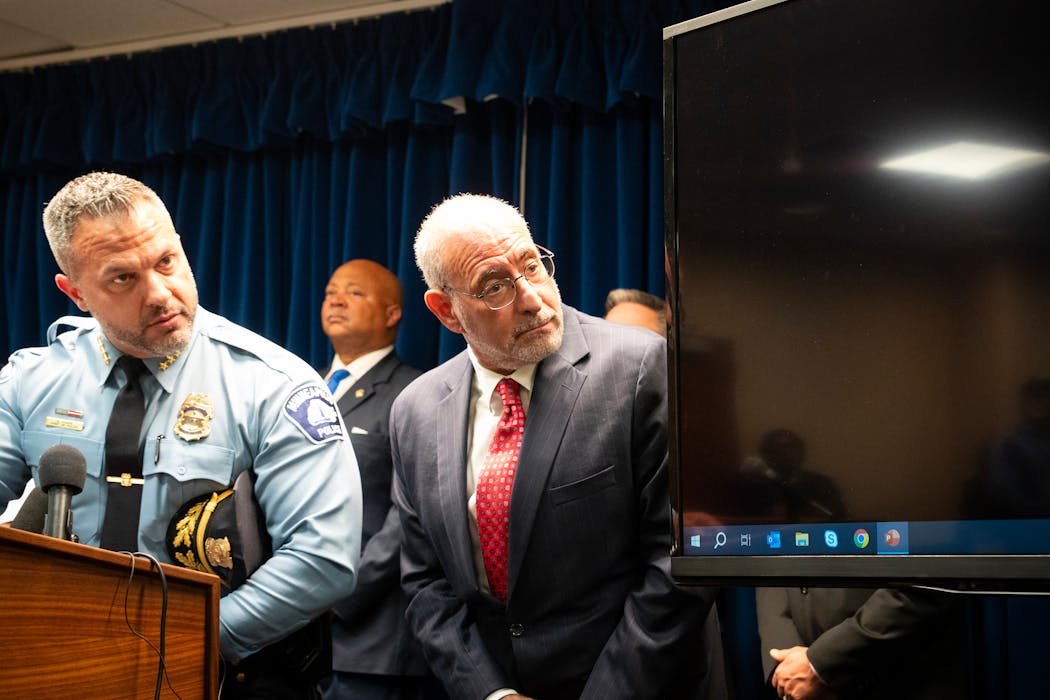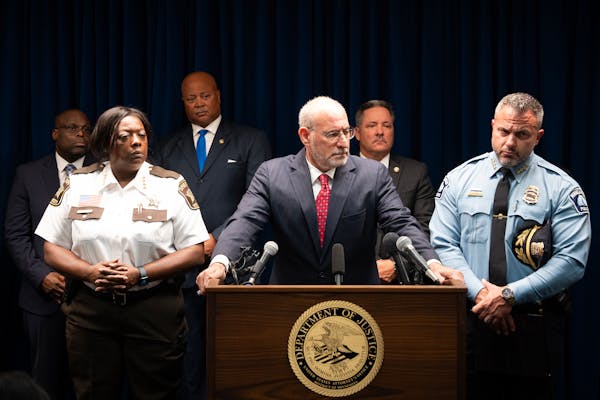At some point the sound of gunshots became so common on Juliee Oden's block that she installed a steel plate behind the headboard of her bed in case a stray bullet pierced her walls while she slept.
Oden, 57, has lived in Minneapolis' Jordan neighborhood for two decades, and it had never felt so bleak as that period starting in 2020. On her way to work she'd watch the open-air drug market thriving outside a gas station down the street. Once, she saw a lifeless body lying in a parking lot just as the ambulance was arriving. Contractors fearful of entering the neighborhood turned her down for home improvement projects.
But this summer, Oden said, has felt markedly different, like a collective fever finally broke.
"There is a great sense of calmness compared to recent years," she said. "I am still seeing these things, but it's like living in a mountain in Utah compared to how it was."
The progress Oden sees is real, and it's not just in her neighborhood. After three of the most violent years in the city's history, Minneapolis gained a foothold this summer in its fight to bring down violent crime.
The city has recorded 20 fewer homicides than at this time last year, on pace for a 33% decline.
Other metrics show similar positive trends, according to city data analyzed by the Star Tribune: 9% fewer aggravated assaults, 26% fewer robberies, 30% fewer gunfire reports, 33% fewer shootings victims and 52% fewer carjackings.
Violent crime — murder, aggravated assault, rape and robbery — is down 12% overall from last year to its lowest point of the 2020s so far, the data show. Only a record-breaking surge in auto thefts bucks the pattern.
Minneapolis Police Chief Brian O'Hara said the positive trends show the department's data- and partnership-driven strategies, focused on taking guns off the streets, are making a difference. "It's a matter of continuing to keep our foot on the gas," O'Hara said in an interview last week.
Even with these reductions, however, Minneapolis is not yet back to normal. The city's 260 reported gunshot victims is still higher than any year on record before 2020, when the COVID-19 pandemic and murder of George Floyd upended everyday life. Violent crime rates remain 11% higher than a five-year average before 2020.
And some neighborhoods, mostly in the southern half of the city, have seen slower declines. Last month, two mass shootings in Phillips community neighborhoods left one dead and at least 14 injured.
Not a uniform decline
For Minneapolis and dozens of cities across the United States, the crime surge traces back to summer 2020.
Before that year, the city had enjoyed some of its lowest violent crime rates since the 1980s, averaging about 40 homicides per year. By the end of 2021, the homicide count hit 97 — tied for the record set in 1995. Minneapolis also saw the highest rates of gunfire ever recorded, with more than 500 shooting victims each of the past three years. In 2020-2021, the Fourth and Third precincts — located in north and south Minneapolis — bore the brunt of violent surges, along with some areas of downtown.
Last year, the city witnessed its first evidence of a reversal: The number of shots fell 20%, resulting in 100 fewer victims compared with 2021. The homicide count dropped to 82. Carjackings, which peaked in 2021, dipped about 20%.
The decline is playing out differently by neighborhood. "The increase wasn't uniform, so the decreases won't be uniform," said Ryan Larson, an associate professor of criminology at Hamline University.
In 2023, areas of downtown and the North Side have seen violent crime drop nearly 20% and gunfire reports by a third or more, according to city data. Third Precinct gunfire rates have fallen more incrementally — by around a quarter — but still account for a decline of 400 fewer reports of shots fired.
Gunfire reductions in the Fifth Precinct — a south Minneapolis area bound by Interstate 35W, I-94 and city limits to the west and south — have been less stark at 14%, and some areas buck citywide violence trends. For instance, robberies in Lyndale have doubled and Lowry Hill East has recorded 10 shooting victims in two consecutive years, while gunfire volume has barely shifted in either neighborhood.
What is working?
In May, Minnesota U.S. Attorney Andrew Luger announced a breakthrough case he said marked a shift in how federal law enforcement approached urban crime: His office was charging two street gangs with a statute used to take down organized crime syndicates like the Mafia.
Federal prosecutors charged 45 alleged members of the Highs and Bloods — Minneapolis gangs linked to allegations of murder, robbery, drug conspiracy and gun crimes — by the Racketeer Influenced and Corrupt Organizations Act, a federal statute commonly known as RICO. The case was made with help from Minneapolis police investigators embedded in the U.S. Attorney's Office — O'Hara's idea, said Luger in an interview, which has allowed law enforcement and federal prosecutors to be nimbler in pursing the city's most violent people.
O'Hara and Luger pointed to the RICO case as an example of how partnerships with state, federal and county law enforcement agencies have been key to addressing the complicated forces driving up violent crime rates in the city — and beyond.
"The reality is, the way Minneapolis goes, the entire state — the entire region — will go in terms of crime," O'Hara said.
Police also worked with the Minnesota Attorney General's Office to curb violence outside Merwin's Liquor and the Winner Gas Station, an infamous North Side corner that was an epicenter of an outsized number of homicides for more than a decade. Luger charged another conspiracy case last month against 14 more alleged gang members.
O'Hara took over a Minneapolis Police Department in crisis less than a year ago, and his mission is two-fold: reduce crime while systemically reforming a police force under state and federal court-ordered mandates.
He said this week that regaining the trust of community members is critical to addressing the violence. "We're not going to drive crime down and keep it down unless people trust us enough to tell us when a crime happens," he said.
O'Hara said the current progress is "absolutely not sustainable" without more officers, which the department is struggling to hire. Department staffing has dwindled to 583, said police spokesman Brian Feintech — down about 300 from 2019.
O'Hara said they've had to "go back to the basics" and "reinvigorate the Compstat process" — a data-driven approach to triaging police resources. Even with low staffing, O'Hara said Minneapolis police have taken more guns off the streets this year than ever before.
"We've been trying to be as precise as possible, focusing on the very small percentage of the people in the population that are pulling triggers," he said.
Mayor Jacob Frey, who is in charge of the Police Department, lauded the progress of officers confiscating guns. He pointed to a stark difference in the area of Downtown West called "Warehouse District Live" as an example. This year, Frey said, the entertainment-centric nucleus of downtown saw 26 consecutive weekends without a shooting. In 2022, the record was three weekends, he said.
"I've hear so many people say you can't prosecute and arrest your way out of these problems," Frey said. "And they're right. ... But it's absolutely an important component."
'You got to keep going'
Minneapolis is among at least 80 cities to see reductions in homicide counts this past year, according to a Star Tribune analysis, indicating global factors at play as well.
Chris Uggen, a sociology professor at the University of Minnesota, said criminologists are still disentangling what drove violence to spike in 2020, but it was a period of "great disorder" that disrupted social norms.
"That seems to be settling to some extent," Uggen said.
Larson, the Hamline professor, concurred, noting a "re-establishment of informal social control" as the pandemic-era disruptions fade.
Moving forward, Luger said his office will continue its strategy of targeting violent criminals for federal prosecutions, which often carry harsher penalties than state ones, and doing so in public fashion as a deterrent. "As the numbers come down, you got to keep going, because new people will rise to fill a void," he said.
Oden cited federal prosecutions as making a difference in her north Minneapolis community. In 2020, the number of reported shots fired in the Jordan neighborhood more than doubled from the year before. This year, violent crime in Jordan has fallen 15% and gunfire reports by about one-third.
She hopes that within five years her neighborhood will be safer than ever. But even then, Oden said, the steel plate will not leave its place behind her headboard.
"That's with me until I actually do die — of hopefully natural causes."

Want to share info with the Star Tribune? How to do it securely

'Safe recovery sites' would offer syringes, naloxone and more to people using drugs. The plan could be in peril.
New Minnesota GOP leaders seek peace with party's anti-establishment wing

Who is Republican Lisa Demuth, Minnesota's first House speaker of color?



